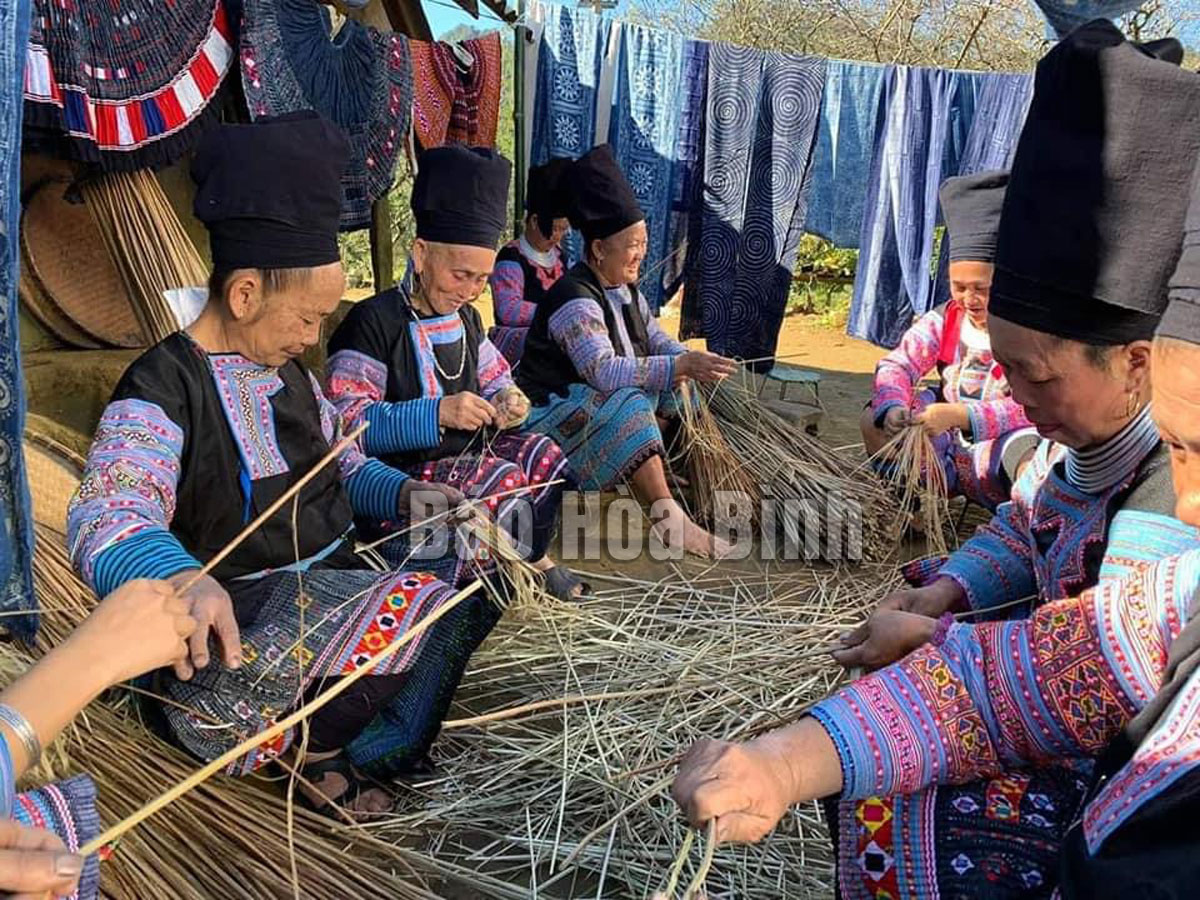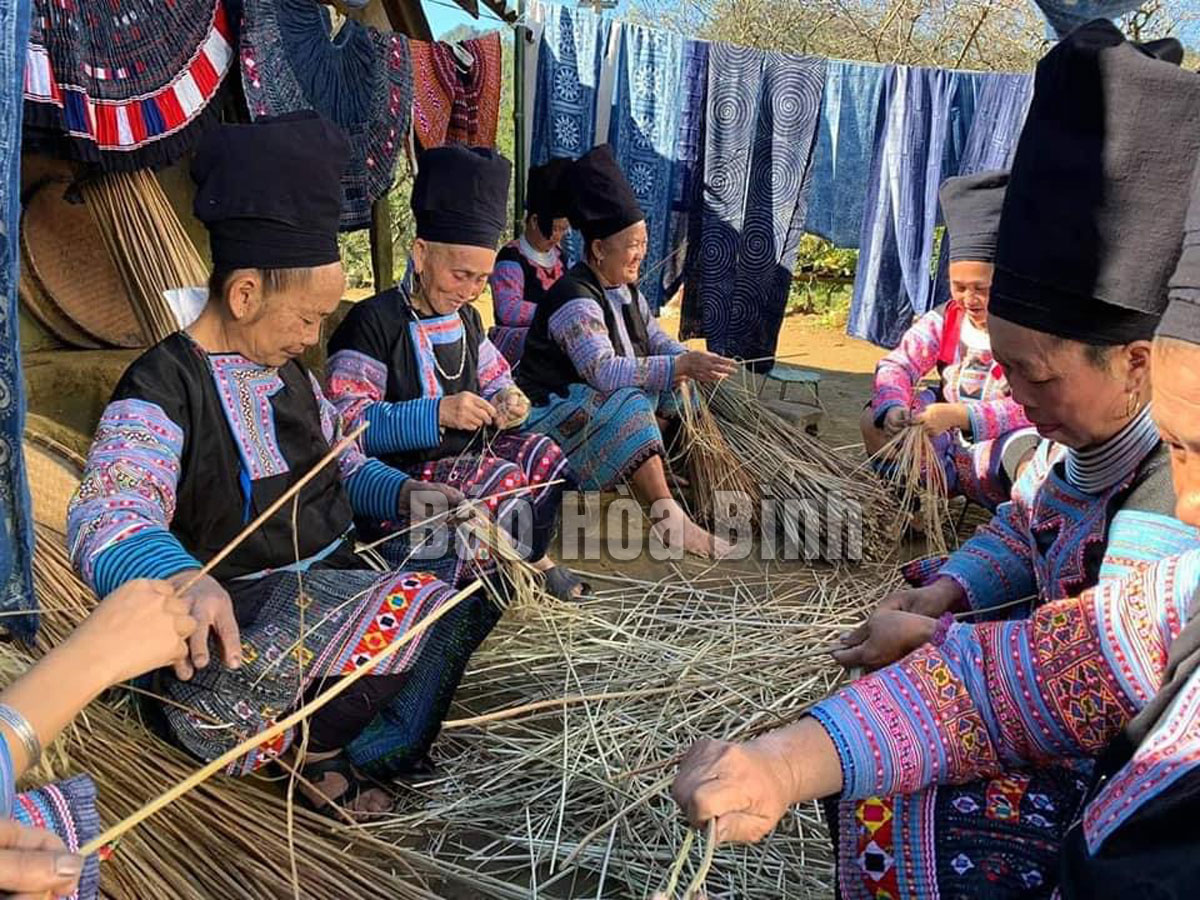
(HBO) - The costumes of Mong women are very colorful. It takes a lot of time and effort of grandmothers, mothers, sisters and workers to make a complete costume. The ingenuity of Mong women is that they can make their own ethnic costumes with their skillful hands.
 Mong women from Pa Co commune (Mai Chau) are plucking flax fibers weaving fabric to make their traditional costumes.
Mong women from Pa Co commune (Mai Chau) are plucking flax fibers weaving fabric to make their traditional costumes.
Hang Kia and Pa Co are two communes of Mong ethnic people in Mai Chau district with 1,283 households, accounting for 97% of the population, of which, Hang Kia commune has 685 households, and Pa Co commune 598 households. The people always pay attention to preserving the cultural values imbued with the national identity, including thew traditional costumes.
The costume of Mong women includes a head-scarf, a woolen scarf (also a head scarf), which are embroidered by hands, a skirt and a bib made by hand, too. The costume is beaded very sophisticatedly and meticulously. It For rough sewing 1 set of clothes about 3-4 days to sew 1 set of clothes, the embroidery takes more than 2 weeks. It takes to up to 1 month for a sophisticated set.
Sung A Lan from Thung Man hamlet, Hang Kia commune, says: "I am 15 years old, however, I have mastered how to embroider the brocaded dress of my ethnic grouyp. In ny childhoood, when I saw my grandmother and mother embroidering, I like it very much. When I was over 10 years old, my mother taught me the first embroidery strokes, and I have been tinkering and learning more by myself in my free time since then. Now, I have been able to embroider and sew clothes for myself and my whole family”. Lan still clearly remembers that her grandmother and mother often say every Mong girl must know how to sew, weave, and embroider, which is also the standard for getting married.
The dress of Mong women not only meets the needs of wearing but also has the aesthetic value. It is beautifully decorated, a measure of the ingenuity of Mong women. The beauty of the dress is a cultural work, linking the needs of everyday life with the aesthetic needs. The patterns and textures on the clothes are biased towards the colors. It is a combination of hot colors, creating striking and impressive feelings. Not paying too much attention to the textures, the patterns on the clothes of the Mong people are the color mixture as well as the interweave, changing the material with the smooth patches (fabric grafting), the embossed patches (embroidery) or details that make the decoration art on the costumes of Mong people unique and different from some other ethnic groups.
Mr. Kha A Lau, the chairman of the People's Committee of Hang Kia says: In the past, Mong women only embroidered by hand, then they can afford to buy more sewing machines to sew and support the process of making beautiful clothes, taking less time. A set of Mong people’s costume is quite expensive, usually from 2 to 3 million VND, so if they sell it, they can also improve the income for the families. Compared with other goods, the sale of Mong people’s costumes gives a higher income, many households in the commune have a stable income from selling this item”.
In terms of techniques and the fine arts in the stages of weaving and creating the patterns on fabrics or fabric products from fabric, Mong people have mastered many skills and techniques such as weaving, embroidering, stitching and painting on fabrics. Each method has its own technical characteristics, taking its advantages to complement each other, forming a complete symphony for the art of shaping on the textiled products.
Mr. Giang Y Dua, the Chairman of the Women's Union of Hang Kia Commune says: The patterns on the costumes of Mong ethnic women express their thoughts and feelings. Additionally, it is also a criterion for assessing the ability, the dignity of the women. The women who are good at embroidery are highly appreciated and respected by the whole community. Before going to be a bride, a Mong girl is given 1-2 sets of dresses by her birth mother and it is considered as a dowry. Therefore, the beautiful embroidered dresses become the property of the women, and for the young girls, learning to embroider is a duty like having to take care of the clothes for the family. After becoming a wife, a mother, Hmong women still continue embroidering and printing many patterns so that their husbands and children can dress well.
Ms. Ha Thi Hoa, the Head of the District’s Culture and Sports Department says: "In order to preserve and promote the value of the traditional costumes of the Mong ethnic group, we continue implementing the solutions, the mechanisms and the policies supporting, especially supporting the artisans in the vocational training so that Mong women's costumes can be tourism products, associating with preserving the cultural beauties, contributing to promoting the socio-economic development as well as increasing the income for the people”.
With an increasingly vibrant and widespread emulation movement aimed at building cultured residential areas and cultured families, Yen Thuy District has been making steady progress toward improving both the material and spiritual well-being of its people, while fostering a civilized, prosperous, beautiful, and progressive community.
Once lacking recreational spaces and community facilities, Residential Group 2 in Quynh Lam Ward (Hoa Binh City) has recently received attention for the construction of a new, spacious, and fully equipped cultural house. The project followed the model of state support combined with public contributions in both labor and funding.
The "All people unite to build cultural life" movement, which has been effectively integrated with Kim Boi district’s socio-economic development goals, is fostering a lively spirit of emulation across local residential areas, hamlets, villages, public agencies, and enterprises. In addition, through the initiative, traditional cultural values are being preserved and promoted, while community solidarity and mutual support in poverty reduction and economic development are being strengthened.
A working delegation of the Hoa Binh provincial People’s Committee led by its Permanent Vice Chairman Nguyen Van Toan on June 11 inspected the progress of a project to build the Mo Muong Cultural Heritage Conservation Space linked to tourism services in Hop Phong commune, Cao Phong district.
Born and growing in the heroic land of Muong Dong, Dinh Thi Kieu Dung, a resident in Bo town of Kim Boi district, in her childhood was nurtured by the sweet lullabies of her grandmother and mother. These melodies deeply imprinted on her soul, becoming an inseparable part of her love for her ethnic group's culture. For over 20 years, this love for her hometown has driven Dung to research, collect, and pass down the cultural values of the Muong people to future generations.
In the final days of May, the Ethnic Art Troupe of Hoa Binh Province organized performances to serve the people in remote, mountainous, and particularly disadvantaged areas within the province. These were not just ordinary artistic shows, but they were the meaningful journeys aimed at spreading cultural values, enhancing the spiritual life of the people and contributing to the preservation of ethnic minority cultural identities.



 Mong women from Pa Co commune (Mai Chau) are plucking flax fibers weaving fabric to make their traditional costumes.
Mong women from Pa Co commune (Mai Chau) are plucking flax fibers weaving fabric to make their traditional costumes.